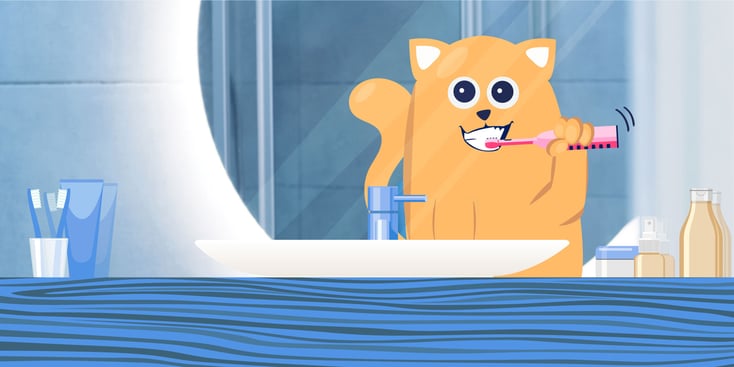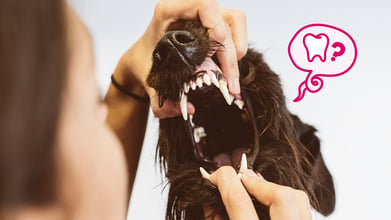Periodontal Disease in Cats: A Complete Guide

Table of Contents
Periodontal disease is one of the most common cat diseases seen by veterinarians. However, it’s easy to miss the early signs of painful periodontal disease.
Cats can suffer in silence for a long time before finally showing their pet parents their secret pain. Periodontitis can lead to permanent tooth decay, tooth loss, and tooth root abscesses.
Untreated, periodontal disease can even cause other cat diseases! These include infections in the heart valves or damage to the kidneys and liver.
So, it is crucial to start treatment for periodontal disease in cats as soon as possible.
How Do Cats Get Periodontal Disease?
There are about 400 to 500 species of bacteria in your cat’s mouth. These bacteria stick to the teeth and form a film called plaque, which is difficult for the body to remove on its own.
Plaque can be seen as a white or gray coating on the tooth surface. Plaque build-up turns into tartar over time; this tartar is seen as a grey/green/brown material on the tooth.
The body is unable to remove tartar meaning it is permanently stuck to the tooth. This allows bacteria to have contact with the sensitive gums, resulting in cat dental disease.
How Will I Know If My Cat Has Periodontal Disease?
Signs of periodontitis are:
- Bleeding gums
- Smelly breath
- Pawing or rubbing at the face
- Drooling
- Blood in the saliva
- White, gray, or brown coloring on the tooth
- Reduced appetite
- Not wanting to eat kibble
- Dropping food
- Chewing on one side of the mouth only
- Swelling around the mouth or chin
Pet Dental Care Pop Quiz
1. Adult dogs have 32 teeth.
2. Adult cats have 30 teeth.
3. Your pet should have all of their teeth in by the time they are 3-4 months old.
4. It’s safe to use human-grade toothpaste with your pet.
5. Heart disease is the most common disease in pets.
6. The smaller the dog, the more susceptible they are to developing dental problems.
7. Your pet should have a professional dental cleaning at least once per year.
8. If I brush my pet’s teeth at home, they don’t need a professional dental cleaning.
View Results
Pet Dental Care Pop Quiz
1. Adult dogs have 32 teeth.
2. Adult cats have 30 teeth.
3. Your pet should have all of their teeth in by the time they are 3-4 months old.
4. It’s safe to use human-grade toothpaste with your pet.
5. Heart disease is the most common disease in pets.
6. The smaller the dog, the more susceptible they are to developing dental problems.
7. Your pet should have a professional dental cleaning at least once per year.
8. If I brush my pet’s teeth at home, they don’t need a professional dental cleaning.
Share Quiz
Can We Predict Which Cats Get Periodontal Disease?
Some cats are more likely to get periodontal disease than others. As with people, a lot of it comes down to genetics, which no one can change.
Short-nosed breeds such as the Persian or British Shorthair have smaller mouths for the teeth to fit in. This smaller mouth can often be overcrowded, resulting in crooked teeth.
Crooked teeth are easier for bacteria to stick to, and gum disease often sets in faster.
Extra or retained teeth can also increase the risk of dental disease in cats.
How Is Periodontal Disease Treated?
Periodontal disease treatment in cats is not a one-time thing. Cats need lifelong, regular dental care to control gum disease and dental pain.
So, how do we do this? There are many ways we can treat periodontal disease in cats:
Firstly, book an appointment with a veterinarian for a full dental exam. Cats need yearly dental cleaning and radiographs taken under general anesthetic.
However, cats with gum disease or who have had teeth removed previously need a check-up every three to six months.
While this can sound scary, it’s considered a routine procedure in the vet clinic. A general anesthetic allows the veterinarian to fully examine your cat’s teeth. X-rays pick up painful dental diseases hidden by the gums that are not necessarily seen by the naked eye. Diseased, painful teeth will be removed. The veterinarian will scale off the tartar and polish the remaining teeth. Medications or mouthwash may be prescribed to treat any remaining infection.
What Can I Do at Home to Help My Cat?
Here's a list of things you can do to treat periodontal disease for cats in home:
Brush Their Teeth
Daily tooth brushing is the best thing you can do to prevent and slow down the progression of periodontal disease in your cat’s mouth. You may think your cat would hate having their teeth brushed, but most cats love it! Use pet-friendly toothpaste that comes in tasty flavors like chicken or fish. A finger toothbrush is perfect for cats’ small mouths.
If you have never brushed your cat’s teeth before, start small. First, let your cat lick the toothpaste from your finger. Then gradually introduce your finger to the front teeth and then the back over a few days. Gradually work up to using the finger brush on all the outside surfaces of the teeth. Don’t try to brush the inside of the teeth; you may get bitten and brushing in this area is stressful for your cat.
Dental Diets
Prescription dental diets are available to help reduce periodontal disease. These large biscuits act like chewing gum on the tooth. They stick to the teeth when the cat chews and pull off the plaque as the cat removes the tooth from the biscuit. The dental diets work best for the bigger back teeth.
The Veterinary Oral Health Council (VOHC) has made a list of veterinary-approved dental diets, treats, and supplements. Check this list before buying food or treats. The products on the list have been scientifically proven to work. You can relax knowing the products bought will do the job you bought them for.
Dental Treats
Dental treats are helpful for cats who won’t allow tooth brushing. Use the VOHC website to find effective dental treats for your cat. Dental treats work by scraping the plaque of the tooth when the cat chews on the biscuit or chew.
However, too many treats can cause an increase in calorie intake, which is bad for your cat. If using dental treats, stop or lower the number of other treats you feed. If you don’t feed other treats, reduce the amount of kibble or wet food you are giving to maintain a balanced diet for your cat.
Prevention Is Key
According to the Cornell University School of Veterinary Medicine, between 50 and 90 percent of cats over four years of age suffer from some form of dental disease.
Prevention is key and only with a team effort of home care and veterinary treatment can we hope to keep our cats’ mouths healthy long term.
If you don’t have a veterinarian who can help you with your cat’s dental care, try booking a veterinary check-up with BetterVet. We'll help your cat with their dental problems right from the comfort of your home!






